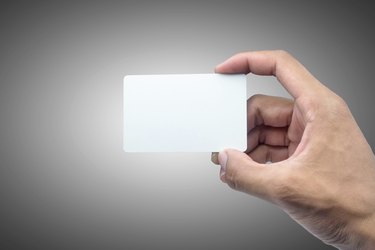
Whether you want to create humorous gifts for friends and family, craft a mock license for a Tumblr site or Twitter profile, or build identification cards for a group or club, you can put together all the elements necessary for a faux or real ID in an Adobe Photoshop document. To help you set up and refine your composition, take advantage of live and re-editable text, solid-color adjustment layers and Smart Object settings that help preserve the editability of imported images.
Step 1
Set up your Adobe Photoshop document with the same dimensions as your driver's license or credit card, both of which measure approximately 3.375 inches wide by 2.125 inches high. For onscreen-only use, establish the file in RGB color at 72 pixels per inch; for a printable document, use CMYK color at 300 ppi.
Video of the Day
Step 2
Open the file that contains your ID photo, and set it and your ID card document side by side. Press "V" to switch to the Move tool. Drag and drop the photo from the live area of the image file to the live area of your working document. This step duplicates the image in the target document without using the clipboard. To make the layer into a Smart Object that you can resize more than once without throwing away image data, open the "Layer" menu, choose its "Smart Objects" submenu and select "Convert to Smart Object," or open the fly-out menu at the top right corner of the Layers panel and choose the same command.
Step 3
Press "Ctrl-T" to enter Free Transform mode. Type numeric values into the width and height entry fields in the Options bar to set the size of the photo, or click and drag the control points on the outside corners of the transformation box that appears around the image layer. To constrain manual resizing so it alters the image proportionately, hold down the "Shift" key while you scale the image. Click and drag the photo to reposition it where you want it to appear. When you finish your transformations, press "Enter" to finalize them.
Step 4
Click on the foreground color swatch in the Tools panel and set the color for the type on your ID card. To set the swatches to black for the foreground and white for the background colors, press the "D" key.
Step 5
Press "T" to activate the Type tool. Select a typeface, style, size, anti-aliasing mode and alignment in the Options bar or Character panel. If your Photoshop workspace doesn't include the Character panel, open the "Window" menu and choose "Character" to reveal it.
Step 6
Click with the Type tool on the live area of your document to create a new text layer. Type your text or paste in a selection you copied from another file. Click on the check mark icon in the Options bar to finalize the text layer's content. Create as many layers as you need for the various text areas on the ID card, including your personal information as well as a header that identifies the type of ID. Select individual characters, words or lines within a text layer to alter their appearance separately from the rest of the text.
Step 7
Open the "Layer" menu and choose "New Fill Layer," or click on the unlabeled New Adjustment Layer button at the bottom of the Layers panel and choose "Fill Layer" from the drop-down menu that opens. Fill layers provide areas of solid, gradient or patterned color behind a text header or some other portion of the ID card content. To constrain the area the Fill layer covers, press "M" to switch to the Selection tool, and click and drag to create a selection before you create the Fill layer.
Step 8
Save your file in PSD format to preserve its layers. To use your work online, create a copy of the file in JPG or PNG format.
Video of the Day